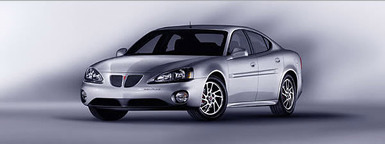
San Francisco: The all-new Grand Prix is instantly recognized as a Pontiac by its
characteristic split grille and cat's-eye shaped headlights. Another recent styling cue,
the radical body-side cladding is gone, fortunately.
While a four-door sedan, the roofline lends a
coupe-like look. All in all, the new Grand Prix is very good looking. Besides carrying
over styling cues from previous years, many of the mechanical components are used again.
The 2004 Grand Prix comes in two versions, GT and GTP. GT
models are packaged in two ways. The GT1 ($22, 635) is equipped like your typical rental
car with power steering/windows/brakes, radio/CD and air conditioning. Anti-lock braking
with traction control and tire pressure monitor is a $600 option. Most people will
probably opt for the GT2 ($24,535) that comes with items expected today in cars in this
market segment. The GTP ($26,735) offers more performance and handling for the driving
enthusiasts. With the Competition Group package, the GTP is even more fun.
Only one engine is used in the Grand Prix, GM’s
venerable and proven 3.8-liter V6. It comes in two flavors for the Grand Prix. The
GT1 and GT2 gets a version that produces 200 horsepower at 5200 rpm and 225 foot-pounds of
torque at 4000 rpm. A supercharger is added for the GTP to boost the output to 260 at 5200
rpm and 280 pound-feet at 3600 rpm. This represents a 20-horsepower increase over the
supercharged version in 2003.
The only transmission is a four-speed automatic. Whereas much
of the competition has gone to five-speed automatics, the Pontiac’s well-proven
4T65-E Hydra-Matic still does a very good job shifting virtually seamlessly. Fuel economy
is reasonably good - 20 mpg city / 30 mpg highway for the GT and 18 mpg city / 28 mpg
highway for GTP. The fuel tank holds 17 gallons.
The Grand Prix I tested had the Comp G package, easily
identified by two TAPshift (Touch Activated Power) paddles on the steering wheel for
manual shifting. On the other models except the GT1 there are controls for the radio and
cruise control. With the $1395 Comp G package you also get a performance tuned suspension
and Stabilitrak Sport. If StabiliTrak system detects loss of control, power is
automatically reduced and front brakes are applied until control is regained. The Comp G
includes Magnasteer II variable power steering, an upgrade of the Magnasteer I found on
other models.
All Grand Prixs have a new version of WideTrack Handling
System that includes four-wheel independent suspension with four distinct phases of
suspension damping. Brakes are four-wheel discs with red painted calipers on the Comp G.
Sixteen inch wheels are standard with 17-inch wheels shod with performance tires installed
on the GTPs.
The new interior is quite upscale, and a definite improvement
over interiors often found on mid-level GM products. The ignition switch has been moved
from steering column to the instrument panel. The InfoTech Package, included in the CompG
package and a $600 option on the GT2 and GTP includes a driver information center (DIC)
and head-up display that projects selected information on windshield just below the
driver’s field of view. With its four buttons and a four-line read out, the DIC
presents a lot of information.
The very large speedometer and tachometer plus other gauges
are easy to read. Two sets of numbers for speed in mph and kph are gone. By selecting
English or Metric in the DIC, you switch between the two systems by changing the
calibration of the dial. While there lots of buttons and knobs, they are easy to use once
you learn each one’s function. The outside mirrors are SUV-size.
While a sports sedan, the Grand Prix has almost SUV
versatility. For instance, the 60/40 split rear seats fold down together or singly. Also
the front passenger seat folds forward to form a desk-like surface. With seats folded
items as long as nine feet can are be carried with the trunk lid closed. The trunk has a
very low liftover, but like most cars today where styling takes precedence over function,
the opening is somewhat small, but not as bad as some, making it difficult to load in
bulky items. However, the rear doors open to over 80-degrees, making it easier to load
items, and people, into the rear. While listed as a five passenger sedan, except for short
trips only four will ride in comfort.
Acceleration was outstanding with no trace of torque steer
often experienced when delivering gobs of power through the front wheels. The suspension
was taut and steering precise without being harsh and uncomfortable. It is equally at home
on twisty mountain roads as on straight stretches of Interstate.
The GTP is a high performance car for grownups – no
jarring ride or tire squealing takeoffs nor any wild spoilers, wings, or graphics to
attract cops who need to fill their quotas. And how did the GTP with the Comp G handle on
the road? In one word, Great! By Bill Siuru and
Shawn Stewart © AutoWire.Net - San Francisco

Pontiac Home Page
Byline: Syndicated content provided by Tony Leopardo ©
AutoWire.Net
Column Name: The GTP is a high performance car for grownups
Topic: 2004 Pontiac Grand Prix GTP
Word Count: 907
Photo Caption: 2004 Grand Prix GTP
Photo Credits: Pontiac Internet Media
Series #: 2004 - 01
Download the Microsoft Word version here: 2004 Grand Prix GTP
Download the original image file here: 2004 Grand Prix GTP 22k


|
